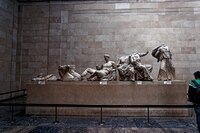Ways of Remembering
In this section of the course, we read selections from philosopher Friedrich Nietzsche's famous essay "The uses and disadvantages of history for life," especially those sections where he discusses the differences between antiquarian, monumental, and critical history. We also looked at ideas in Paul Ricoeur's "Memory-History-Forgetting," where he makes distinctions between memory and history and their relation to one another. He also introduces ideas about different kinds of remembering, such as memories that hold us in their grip (repetition memory) and memories which balance the past (the "space of experience) with the future (the "horizon of anticipation").
Antiquarian History: The Elgin Marbles
I have chosen this image from the British Museum to illustrate what philosopher Friedrich Nietzsche calls "Antiquarian History." Antiquarian History is one of the three ways of relating to the past described by Nietzsche. Nietzsche believes that history should always serve life and energize us. Antiquarian history can do this. The sculptures can stimulate our aesthetic imagination. However, in some cultures, people can become obsessed with the ancient past and this is not good. Nietzsche says that they become "encased in the stench of must and mold." In this kind of history or memory, people are no longer able to live for the present and the future. We spend all our time wandering among the sculptures and other relics with no thought as to how they help us to live now. (contributed by JS)
Monumental History: An Image of a Moon Landing
Nietzsche states that one way history pertains to the living person is as a being who acts and strives. We remember the past through monuments because they tell us who we have been and help to orient our roadmap to who we want to be (individually, but also as a collective). One monument which exemplifies this is the picture of the 1969 moon landing – man’s first walk on the moon. The monument here is not the flag itself, but this notorious photograph. While there are other forms of media commemorating this event, newspaper clippings and television footage etc., it is the proliferate use of the photograph, especially via the internet that makes it the monument in Nietzsche’s definition. This image is also controversial, it has been the subject of much debate over its authenticity, and so we view it as believer or non-believer. But, as Nietzsche notes, regardless of which side we choose, we are all “…the outcome of this event including its aberrations and its passions,” meaning regardless of the authenticity of the event itself, we have become a space-oriented people because of this event and this image. This landing and subsequent other missions inspired humans to more than just earthbound existence, we changed the way we thought about who we are and where we wanted to go (contributed by TA).
Peter the Great in Moscow
Peter the Great (1682-1725) was one of the most influential, society-building Russian Tsars. However, I include this image not because it is Peter the Great, but to illustrate what Nietzsche calls the "monumental" form of history. Monumental history is a way of relating to the past that elevates some persons and events (e.g. Tsar Peter 1) over other persons and events. Monumental history can inspire action by modeling greats deeds and actions. It can draw communities together around admired persons. However, Nietzsche says that in the wrong hands monumental history can also inspire violence and bloodshed. It can lead to the elevation of some histories and memories above others, thus limiting the kinds of inspiration that we can take from the past. This statue is monumental not only because it tells the story of Peter the Great, but also because the statue itself is large and elevated. It dominates the surrounding space in the same way that monumental memories are meant to dominate a culture (contributed by JS)
All Quotations from:
Nietzsche, F. 1873/2011. "On the uses and disadvantages of history for life," Pp. 73-79 in J. Olick, V. Vinitzsky-Seroussi, & D. Levy The Collective Memory Reader. New York: Oxford University Press.


